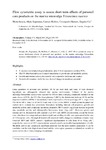Mostrar o rexistro simple do ítem
Flow cytometric assay to assess short-term effects of personal care products on the marine microalga Tetraselmis suecica
| dc.contributor.author | Seoane, Marta | |
| dc.contributor.author | Esperanza, Marta | |
| dc.contributor.author | Rioboo, Carmen | |
| dc.contributor.author | Herrero, Concepción | |
| dc.contributor.author | Cid, Ángeles | |
| dc.date.accessioned | 2017-03-02T16:11:05Z | |
| dc.date.issued | 2017 | |
| dc.identifier.citation | Seoane, M., Esperanza, M., Rioboo, C., Herrero, C., Cid, Á., 2017. Flow cytometric assay to assess short-term effects of personal care products on the marine microalga Tetraselmis suecica. Chemosphere 171, 339-347. http://dx.doi.org/10.1016/j.chemosphere.2016.12.097 | es_ES |
| dc.identifier.issn | 0045-6535 | |
| dc.identifier.uri | http://hdl.handle.net/2183/18207 | |
| dc.description.abstract | [Abstract] Large quantities of personal care products (PCPs) are used daily and many of their chemical ingredients are subsequently released into marine environments. Cultures of the marine microalga Tetraselmis suecica were exposed for 24 h to three emerging compounds included in the main classes of PCPs: the UV filter benzophenone-3 (BP-3), the disinfectant triclosan (TCS) and the fragrance tonalide (AHTN). Concentrations tested, expressed as cellular quota (pg cell−1), ranged from 5 to 40 for BP-3, from 2 to 16 for TCS and from 1.2 to 2.4 for AHTN. A small cytometric panel was carried out to evaluate key cytotoxicity biomarkers including inherent cell properties, growth and metabolic activity and cytoplasmic membrane properties. BP-3 caused a significant increase in growth rate, metabolic activity and chlorophyll a fluorescence from 10 pg cell−1. However, growth and esterase activity decreased in cells exposed to all TCS and AHTN concentrations, except the lowest ones. Also these two compounds provoked a significant swelling of cells, more pronounced in the case of TCS-exposed cells. Although all treated cells remained viable, changes in membrane potential were observed. BP-3 and AHTN caused a significant depolarization of cells from 10 to 1.6 pg cell−1, respectively; however all TCS concentrations assayed caused a noticeable hyperpolarization of cells. Metabolic activity and cytoplasmic membrane potential were the most sensitive parameters. It can be concluded that the toxicological model used and the toxicological parameters evaluated are suitable to assess the toxicity of these emerging contaminants. | es_ES |
| dc.language.iso | eng | es_ES |
| dc.publisher | Elsevier | es_ES |
| dc.relation.uri | http://dx.doi.org/10.1016/j.chemosphere.2016.12.097 | es_ES |
| dc.subject | Microalga | es_ES |
| dc.subject | Emerging pollutant | es_ES |
| dc.subject | Personal care products | es_ES |
| dc.subject | Flow cytometry | es_ES |
| dc.subject | Cytotoxicity | es_ES |
| dc.title | Flow cytometric assay to assess short-term effects of personal care products on the marine microalga Tetraselmis suecica | es_ES |
| dc.type | info:eu-repo/semantics/article | es_ES |
| dc.rights.access | info:eu-repo/semantics/embargoedAccess | es_ES |
| dc.date.embargoEndDate | 2018-12-31 | es_ES |
| dc.date.embargoLift | 2018-12-31 | |
| UDC.journalTitle | Chemosphere | es_ES |
| UDC.volume | 171 | es_ES |
| UDC.startPage | 339 | es_ES |
| UDC.endPage | 347 | es_ES |






